Philadelphia’s Jewish Museum is emerging from bankruptcy
The museum on Independence Mall, closed since the start of the pandemic, hopes to re-open this fall.

The museum on Independence Mall, closed since the start of the pandemic, hopes to re-open this fall.
